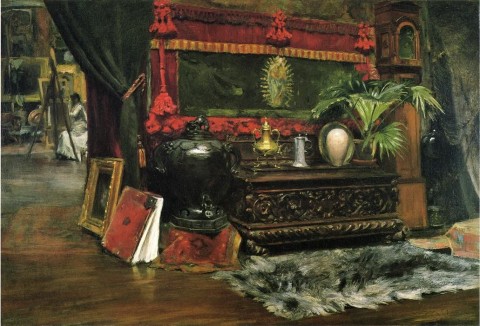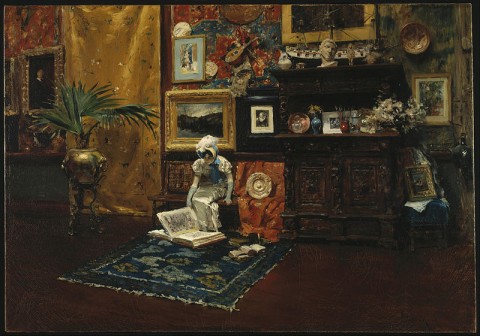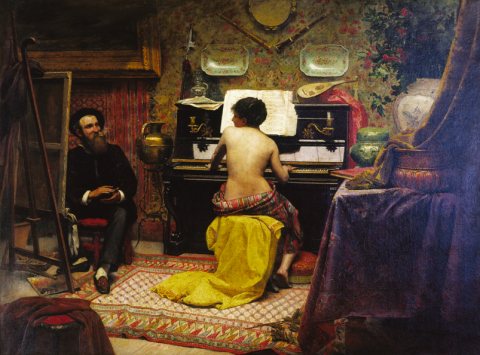Thursday, September 11th, 2014
Women Painted into “Exotic” Studio Scenes
Recently I have been researching about the American artist, William Merritt Chase. Chase lived an extravagant lifestyle in New York in the late 19th century. He famously moved into Albert Bierstadt’s old studio on Tenth Avenue and used this space not only to paint, but to showcase his collection of various foreign and exotic objects including Japanese fans, Egyptian pottery, Italian swords, and even a stuffed flamingo!1 Chase was undoubtedly proud of his collection; he would open up his studio to the public once per week. Additionally, he painted several scenes of his studio interior. Even after financial difficulties forced Chase to sell his studio and auction off its contents in 1895, Chase continued to paint the interior of the studio of his summer home in Shinnecock Island, New York.
As I’ve been looking at these paintings of Chase’s studio and collection, I’m struck with how often he included a female figure within the space. These women are usually involved in some type of action, which gives them an element of subjecthood that I appreciate. Such is the case with A Corner of My Studio (c. 1895, shown above), which depicts a woman painting in the background. I also like Chase’s Studio Interior (c. 1882, shown below) which shows a woman reading book.
Despite the action of these female figures, though, I think that these women also are supposed to function in a symbolic light, given the exotic nature of Chase’s collection. Exotic cultures and their respective products had feminine associations in the 19th century, in part because these cultures were linked to nature and fertility. I think that the female figures in Chase’s painting are meant to heighten the exoticism of the objects in Chase’s collection. Along these lines, then, these active female subjects are also reduced to decorative elements within the studio space, inviting a “to-be-looked-at-ness” that is not dissimilar to the exotic plants, vessels, rugs, sculptures, and pictures that Chase has placed on display. As a result, I think these females vacillate between subjecthood and objecthood.
Other paintings by Chase that have deal with female figures within exotic interiors (some more exotic than others) include In the Studio (c. 1884), The Inner Studio, Tenth Street (1882), Alice in Studio in Shinnecock Long Island Sun (c. 1900), Weary aka Who Rang? (c. 1889), Did You Speak to Me? (1897), and also the pastel drawing May I Come In? (1893). Most, if not all, of these works of art are depictions of Chase’s studios (I am only uncertain about where Weary aka Who Rang? was painted – does anyone know?). When looking at all of these paintings by Chase, I am reminded of another 19th century artist, the Brazilian painter José Ferraz de Almeida Júnior. Almeida Júnior also was interested in depicting female figures within the studio space, although he added an element of sensuality to his works of art by depicting nude or partially-undressed figures.
Also like Chase, Almeida Júnior includes a female figure in an artist’s studio that is surrounded by exotic objects. The decorative and exotic nature of the fertile female body is emphasized through the partially-undressed female figure; her exposed, curvy form is placed in the center of the composition for the viewer to immediately appreciate. Although I do feel like Chase’s female figures have much more subjecthood and individual personality than Almeida Júnior’s sensuous model in this painting (we can’t even see her face!), in both instances the female figure helps to heighten the exoticism of the artist’s luxurious objects found within the studio space.
I think that Almeida Júnior especially focuses on the sexual and sensual associations of the female model within the studio space with another painting, O Importuno (shown below).2 Although Almeida Júnior does not depict the female model with exposed flesh in this work of art, the subject of the cowering model in underclothes (presumably hiding because someone has knocked on the door) suggests an element of sexuality and even scandal. And, once again, the decorative female form seems to be associated with exoticism and luxury: the model hides behind a richly embroidered tapestry, while she stands next to an Oriental rug and fur rug pelt.
While both of Chase and Almeida Júnior depict the female figure within luxuriously-decorated interiors, I feel like there are some differences. Chase tends to focus more on the collection objects within the studio space, and he seems to add the female figure as another decorative element. It almost seems to me like Chase places more focus on his collection; the female figure is ancillary, yet symbolically important. On the other hand, I think that Almeida Júnior wants to focus more on the suggestive interactions between the model and artist, and he uses the luxurious interior to heighten those connections between the female form and exoticism. Do you agree?
Do you know of any other 19th century artists who were interested in depicting the female form within an studio filled with exotic luxury items? Probably Gustave Courbet’s The Artist’s Studio; A Real Allegory Summing Up Seven Years of My Artistic and Moral Life (1854-55) would best be seen in opposition to the approach taken by Chase and Almeida Júnior. Even though Courbet depicts an undressed nude female model in the center of this Realist painting, the crowded space and drab, brown background don’t hint at luxury or exoticism to me!
1 Keith L. Bryant, Jr., William Merritt Chase: A Genteel Bohemian (Columbia/London: University of Missouri Press, 1991), 43-62.
2 For further discussion of the eroticism found in this painting and “O Descanso do Modelo” see Daryle Williams, “Peculiar Circumstances of the Land: Artists and Models in 19th Century Brazilian Slave Society,” in Art History 35, no. 4, September 2012: 23-24.



